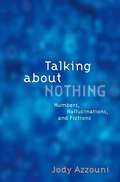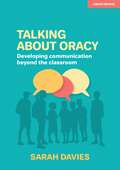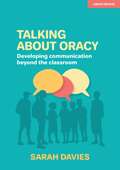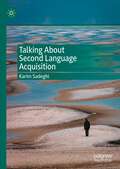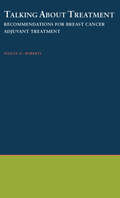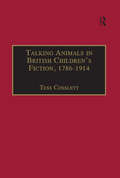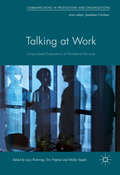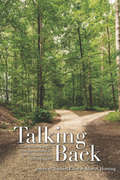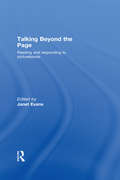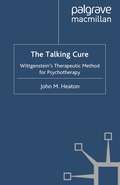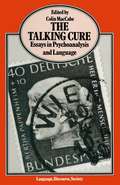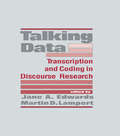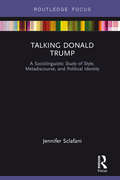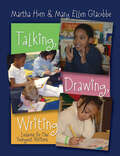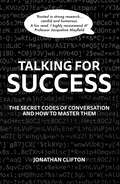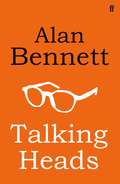- Table View
- List View
Talking About Nothing: Numbers, Hallucinations, and Fictions
by Jody AzzouniOrdinary language and scientific language enable us to speak about, in a singular way (using demonstratives and names), what we recognize not to exist: fictions, the contents of our hallucinations, abstract objects, and various idealized but nonexistent objects that our scientific theories are often couched in terms of. Indeed, references to such nonexistent items-especially in the case of the application of mathematics to the sciences-are indispensable. We cannot avoid talking about such things. Scientific and ordinary languages thus enable us to say things about Pegasus or about hallucinated objects that are true (or false), such as "Pegasus was believed by the ancient Greeks to be a flying horse," or "That elf I'm now hallucinating over there is wearing blue shoes." Standard contemporary metaphysical views and semantic analyses of singular idioms on offer in contemporary philosophy of language have not successfully accommodated these routine practices of saying true and false things about the nonexistent while simultaneously honoring the insight that such things do not exist in any way at all (and have no properties). That is, philosophers often feel driven to claim that such objects do exist, or they claim that all our talk isn't genuine truth-apt talk, but only pretence. This book reconfigures metaphysics (and the role of metaphysics in semantics) in radical ways that allow the accommodation of our ordinary ways of speaking of what does not exist while retaining the absolutely crucial presupposition that such objects exist in no way at all, have no properties, and so are not the truth-makers for the truths and falsities that are about them.
Talking About Nothing: Numbers, Hallucinations, and Fictions
by Jody AzzouniOrdinary language and scientific language enable us to speak about, in a singular way (using demonstratives and names), what we recognize not to exist: fictions, the contents of our hallucinations, abstract objects, and various idealized but nonexistent objects that our scientific theories are often couched in terms of. Indeed, references to such nonexistent items-especially in the case of the application of mathematics to the sciences-are indispensable. We cannot avoid talking about such things. Scientific and ordinary languages thus enable us to say things about Pegasus or about hallucinated objects that are true (or false), such as "Pegasus was believed by the ancient Greeks to be a flying horse," or "That elf I'm now hallucinating over there is wearing blue shoes." Standard contemporary metaphysical views and semantic analyses of singular idioms on offer in contemporary philosophy of language have not successfully accommodated these routine practices of saying true and false things about the nonexistent while simultaneously honoring the insight that such things do not exist in any way at all (and have no properties). That is, philosophers often feel driven to claim that such objects do exist, or they claim that all our talk isn't genuine truth-apt talk, but only pretence. This book reconfigures metaphysics (and the role of metaphysics in semantics) in radical ways that allow the accommodation of our ordinary ways of speaking of what does not exist while retaining the absolutely crucial presupposition that such objects exist in no way at all, have no properties, and so are not the truth-makers for the truths and falsities that are about them.
Talking about Oracy: Developing communication beyond the classroom
by Sarah DaviesWhether considering the art of debate; understanding dialogic teaching methods; the necessity of questioning; or the ability to assess and develop these skills, this book has been written by a classroom teacher, for classroom teachers, in the hope that oracy is dragged out of the shadows and recognised for its significance to improving students’ life skills and future aspirations. When we think about the transferable skills all students will take with them post-academia, oracy, literacy and numeracy should logistically stand proudly side by side. This triad of skillsets are the key components that are used to measure intellectual development in childhood, as well as being further instilled and nurtured in all students throughout their education. However, as children become students and as these students become critical thinkers, an element of this crucial triad appears to have been disowned in recent years. In 2020, oracy appeared to have even less relevance in academia, with the only supportive provision for both Language and Literature to deal with any missed learning being the eradication of any recorded proof of this skill. Yet another indication that oracy has, in some circumstances, been cast into the shadows and banished into the realm of the subject specific curricular. We need to be realistic and embrace the idea that this skill is a necessity to success for all learners post-academia. Training students in the ability to communicate effectively with different audiences in different contexts, needs to be brought back into the spotlight in the hopes that we can attempt to resolve any misconceptions regarding oracy’s place in the curriculum. Through the recognition of the theoretical understanding of communication that will provide the foundations for this book, the aim is that it acts as a supportive guide that will provide suggestions and strategies in order to hopefully empower and encourage educators in all subjects in education, thus restoring the use and appreciation for this necessary skill both inside and outside the classroom. For so long, focus has been on the stress and rigor of assessments, and the fulfilment of the curriculum to ensure that all students can navigate their GCSE examinations. This book will question whether this will have a detrimental effect on students who may have been exposed to fewer of the skills that they will require when leaving an educational setting and venturing into everyday life. So, let’s address the elephant in the room, and provide it a voice.
Talking about Oracy: Developing communication beyond the classroom
by Sarah DaviesWhether considering the art of debate; understanding dialogic teaching methods; the necessity of questioning; or the ability to assess and develop these skills, this book has been written by a classroom teacher, for classroom teachers, in the hope that oracy is dragged out of the shadows and recognised for its significance to improving students' life skills and future aspirations. When we think about the transferable skills all students will take with them post-academia, oracy, literacy and numeracy should logistically stand proudly side by side. This triad of skillsets are the key components that are used to measure intellectual development in childhood, as well as being further instilled and nurtured in all students throughout their education. However, as children become students and as these students become critical thinkers, an element of this crucial triad appears to have been disowned in recent years. In 2020, oracy appeared to have even less relevance in academia, with the only supportive provision for both Language and Literature to deal with any missed learning being the eradication of any recorded proof of this skill. Yet another indication that oracy has, in some circumstances, been cast into the shadows and banished into the realm of the subject specific curricular. We need to be realistic and embrace the idea that this skill is a necessity to success for all learners post-academia. Training students in the ability to communicate effectively with different audiences in different contexts, needs to be brought back into the spotlight in the hopes that we can attempt to resolve any misconceptions regarding oracy's place in the curriculum. Through the recognition of the theoretical understanding of communication that will provide the foundations for this book, the aim is that it acts as a supportive guide that will provide suggestions and strategies in order to hopefully empower and encourage educators in all subjects in education, thus restoring the use and appreciation for this necessary skill both inside and outside the classroom. For so long, focus has been on the stress and rigor of assessments, and the fulfilment of the curriculum to ensure that all students can navigate their GCSE examinations. This book will question whether this will have a detrimental effect on students who may have been exposed to fewer of the skills that they will require when leaving an educational setting and venturing into everyday life. So, let's address the elephant in the room, and provide it a voice.
Talking About Second Language Acquisition
by Karim SadeghiThis book includes interviews with fourteen internationally-acclaimed leading figures in Second Language Acquisition (SLA), who speak on seminal issues in the field as well as their own contributions to SLA scholarship. As well as covering the contributors’ backgrounds and academic achievements, the interviews also delve into their areas of expertise, current theoretical and practical considerations, and contemporary questions, developments and challenges in SLA. The author probes their views on current topics including input and interaction, vocabulary acquisition, teaching pronunciation, writing development, syntactic processing, multilingualism, L1 attrition, complex dynamic systems, processing instruction, instructed second language acquisition, and technology in language teaching. An introduction by the author draws out the key themes and debates in the field today, and highlights areas for future research and further exploration, and a foreword is provided by Rod Ellis. This book will be of interest to students and scholars of Applied Linguistics, Teacher Education and Methodology, and Second and Foreign Language Education.
Talking About Treatment: Recommendations for Breast Cancer Adjuvant Treatment (Oxford Studies in Sociolinguistics)
by Felicia D. RobertsClear and accessible, this book is the first qualitative analysis of the complex conversations that occur between breast cancer patients and their oncologists. Roberts focuses on discussions about possible avenues of treatment, and shows them to be an active and mutual collaboration of information on the one hand, and a subtle delineation of the roles of "expert" and "novice" on the other. Her work highlights how doctors achieve a delicate balance between promoting one particular treatment option while not guaranteeing a cure.
Talking Animals in British Children's Fiction, 1786–1914 (The Nineteenth Century Series)
by Tess CosslettIn her reappraisal of canonical works such as Black Beauty, Beautiful Joe, Wind in the Willows, and Peter Rabbit, Tess Cosslett traces how nineteenth-century debates about the human and animal intersected with, or left their mark on, the venerable genre of the animal story written for children. Effortlessly applying a range of critical approaches, from Bakhtinian ideas of the carnivalesque to feminist, postcolonial, and ecocritical theory, she raises important questions about the construction of the child reader, the qualifications of the implied author, and the possibilities of children's literature compared with literature written for adults. Perhaps most crucially, Cosslett examines how the issues of animal speech and animal subjectivity were managed, at a time when the possession of language and consciousness had become a vital sign of the difference between humans and animals. Topics of great contemporary concern, such as the relation of the human and the natural, masculine and feminine, child and adult, are investigated within their nineteenth-century contexts, making this an important book for nineteenth-century scholars, children's literature specialists, and historians of science and childhood.
Talking Animals in British Children's Fiction, 1786–1914 (The Nineteenth Century Series)
by Tess CosslettIn her reappraisal of canonical works such as Black Beauty, Beautiful Joe, Wind in the Willows, and Peter Rabbit, Tess Cosslett traces how nineteenth-century debates about the human and animal intersected with, or left their mark on, the venerable genre of the animal story written for children. Effortlessly applying a range of critical approaches, from Bakhtinian ideas of the carnivalesque to feminist, postcolonial, and ecocritical theory, she raises important questions about the construction of the child reader, the qualifications of the implied author, and the possibilities of children's literature compared with literature written for adults. Perhaps most crucially, Cosslett examines how the issues of animal speech and animal subjectivity were managed, at a time when the possession of language and consciousness had become a vital sign of the difference between humans and animals. Topics of great contemporary concern, such as the relation of the human and the natural, masculine and feminine, child and adult, are investigated within their nineteenth-century contexts, making this an important book for nineteenth-century scholars, children's literature specialists, and historians of science and childhood.
Talking at Work: Corpus-based Explorations of Workplace Discourse (Communicating in Professions and Organizations)
by Eric Friginal Lucy Pickering Shelley StaplesThis book offers original corpus research in a range of workplace contexts including office-based settings, call center interactions and healthcare communication. Chapters in this edited volume bring together leading scholars in the field of corpus analysis in workplace discourse and include data from multiple corpora. Employing a range of qualitative and quantitative analytic approaches including Conversation Analysis, Linguistic Profiling and Register Analysis, the book introduces unique specialized corpus data in the areas of Augmentative and Alternative Communication, nursing, and cross-cultural communication, among others.
Talking Back: Senior Scholars and Their Colleagues Deliberate the Past, Present, and Future of Writing Studies
by Norbert Elliot Alice S. HorningIn Talking Back, a veritable Who’s Who of writing studies scholars deliberate on intellectual traditions, current practices, and important directions for the future. In response, junior and mid-career scholars reflect on each chapter with thoughtful and measured moves forward into the contemporary environment of research, teaching, and service. Each of the prestigious chapter authors in the volume has three common traits: a sense of responsibility for advancing the profession, a passion for programs of research dedicated to advancing opportunities for others, and a reflective sense of their work accompanied by humility for their contributions. As a documentary, Talking Back is the first history of writing studies in autobiography. Contributors: Jo Allen, Ann N. Amicucci, Akua Duku Anokye, Paige Davis Arrington, Doug Baldwin, John C. Brereton, Judy Buchanan, Hugh Burns, Leasa Burton, Ellen C. Carillo, William Condon, Dylan B. Dryer, Michelle F. Eble, Jennifer Enoch, Joan Feinberg, Patricia Friedrich, Cinthia Gannett, Eli Goldblatt, Shenika Hankerson, Janis Haswell, Richard Haswell, Eric Heltzel, Douglas Hesse, Bruce Horner, Alice S. Horning, Asao B. Inoue, Ruth Ray Karpen, Suzanne Lane, Min-Zhan Lu, Donald McQuade, Elisabeth L. Miller, Rebecca Williams Mlynarczyk, Sean Molloy, Les Perelman, Louise Wetherbee Phelps, Stacey Pigg, Sherry Rankins-Robertson, Jessica Restaino, J. Michael Rifenburg, Eliana Schonberg, Geneva Smitherman, Richard Sterling, Katherine E. Tirabassi, Devon Tomasulo, Martha A. Townsend, Mike Truong, Victor Villanueva, Edward M. White, Anne Elrod Whitney, Kathleen Blake Yancey
Talking Beyond the Page: Reading and Responding to Picturebooks
by Janet EvansTalking Beyond the Page shows how different kinds of picturebooks can be used with children of all ages and highlights the positive educational gains to be made from reading, sharing, talking and writing about picturebooks. With contributions from some of the world's leading experts, chapters in this book consider how:children think about and respond to visual images and other aspects of picturebooks children’s responses can be qualitatively improved by encouraging them to think and talk about picturebooks before, during and after reading themthe non-text features of picturebooks, when considered in their own right, can help readers to make more sense out of the bookdifferent kinds of picturebooks, such as wordless, postmodern, multimodal and graphic novels, are structuredchildren can respond creatively to picturebooks as art formspicturebooks can help children deal with complex issues in their livesTalking beyond the Page also includes an exclusive interview with Anthony Browne who shares thoughts about his work as an author illustrator.This inspiring and thought provoking book is essential reading for teachers, student teachers, literacy consultants, academics interested in picturebook research and those organising and teaching on teacher education courses in children’s literature and literacy.
Talking Beyond the Page: Reading and Responding to Picturebooks
Talking Beyond the Page shows how different kinds of picturebooks can be used with children of all ages and highlights the positive educational gains to be made from reading, sharing, talking and writing about picturebooks. With contributions from some of the world's leading experts, chapters in this book consider how:children think about and respond to visual images and other aspects of picturebooks children’s responses can be qualitatively improved by encouraging them to think and talk about picturebooks before, during and after reading themthe non-text features of picturebooks, when considered in their own right, can help readers to make more sense out of the bookdifferent kinds of picturebooks, such as wordless, postmodern, multimodal and graphic novels, are structuredchildren can respond creatively to picturebooks as art formspicturebooks can help children deal with complex issues in their livesTalking beyond the Page also includes an exclusive interview with Anthony Browne who shares thoughts about his work as an author illustrator.This inspiring and thought provoking book is essential reading for teachers, student teachers, literacy consultants, academics interested in picturebook research and those organising and teaching on teacher education courses in children’s literature and literacy.
The Talking Cure: Wittgenstein's Therapeutic Method for Psychotherapy
by J. HeatonIn the last 15 years there has been a change in direction in our understanding of Wittgenstein; the 'resolute' reading of him places great emphasis on his therapeutic intent and argues that the aim of Wittgenstein's thought is to show how language functions. This book argues that this is highly relevant to understanding psychotherapy.
The Talking Cure: Essays in Psychoanalysis and Language (Language, Discourse, Society)
by Colin MacCabe'The essays are exemplary in their stylistic clarity. One can only compliment MacCabe along with the contributors, for the readability and conceptual variability of this collection. 'E.Ragland-Sullivan, Lacan Study Notes This book, which grew out of a series of seminars at King's College, Cambridge, addresses itself to the problem of understanding the relations between psychoanalysis and language not only in terms of contemporary linguistic and philosophical conceptions of language but also in relation to the wider field of the human sciences.
Talking Data: Transcription and Coding in Discourse Research
by Jane A. Edwards Martin D. LampertThis book presents the reader with a set of diverse, carefully developed and clearly specified systems of transcription and coding, arising from contrasting theoretical perspectives, and presented as alternative choices, situated within the theoretical domain most natural to each. The perspectives represented include first and second language acquisition, interethnic and crosscultural interaction, information structure, and the study of discourse influences on linguistic expression. In the contributed chapters, the designers of these systems provide a distillation of collective experiences from the past quarter century, telling in their own words their perspectives on language processes, how these perspectives have shaped their choice of methodology in transcription and coding of natural language, and describing their systems in detail. Overview chapters by the editors then provide design principles and guidelines concerning issues pertinent to all systems, including such things as reliability, validity, ease of learning, computational tractability, and robustness against error. The final chapter is a compendium of existing computerized archives of language data and information sources together with details concerning data access and use.
Talking Data: Transcription and Coding in Discourse Research
by Jane A. Edwards Martin D. LampertThis book presents the reader with a set of diverse, carefully developed and clearly specified systems of transcription and coding, arising from contrasting theoretical perspectives, and presented as alternative choices, situated within the theoretical domain most natural to each. The perspectives represented include first and second language acquisition, interethnic and crosscultural interaction, information structure, and the study of discourse influences on linguistic expression. In the contributed chapters, the designers of these systems provide a distillation of collective experiences from the past quarter century, telling in their own words their perspectives on language processes, how these perspectives have shaped their choice of methodology in transcription and coding of natural language, and describing their systems in detail. Overview chapters by the editors then provide design principles and guidelines concerning issues pertinent to all systems, including such things as reliability, validity, ease of learning, computational tractability, and robustness against error. The final chapter is a compendium of existing computerized archives of language data and information sources together with details concerning data access and use.
Talking Donald Trump: A Sociolinguistic Study of Style, Metadiscourse, and Political Identity (Routledge Focus on Linguistics)
by Jennifer SclafaniTalking Donald Trump examines the language of Donald Trump’s presidential campaign from the perspective of sociocultural linguistics. This book offers an insight into the many stages of Trump’s political career, from his initial campaign for the Republican nomination, up to his presidency. Drawing from speeches, debates, and interviews, as well as parodies and public reactions to his language, Sclafani explores how Trump’s language has produced such polarized reactions among the electorate. In analysing the linguistic construction of Donald Trump’s political identity, Sclafani’s incisive study sheds light on the discursive construction of political identity and the conflicting language ideologies associated with the discourse of leadership in modern US society. Talking Donald Trump provides a crucial contemporary example of the interaction between sociolinguistics and political science, and is key reading for advanced students and researchers in the fields of sociolinguistics, language and politics, communication studies and rhetoric.
Talking Donald Trump: A Sociolinguistic Study of Style, Metadiscourse, and Political Identity (Routledge Focus on Linguistics)
by Jennifer SclafaniTalking Donald Trump examines the language of Donald Trump’s presidential campaign from the perspective of sociocultural linguistics. This book offers an insight into the many stages of Trump’s political career, from his initial campaign for the Republican nomination, up to his presidency. Drawing from speeches, debates, and interviews, as well as parodies and public reactions to his language, Sclafani explores how Trump’s language has produced such polarized reactions among the electorate. In analysing the linguistic construction of Donald Trump’s political identity, Sclafani’s incisive study sheds light on the discursive construction of political identity and the conflicting language ideologies associated with the discourse of leadership in modern US society. Talking Donald Trump provides a crucial contemporary example of the interaction between sociolinguistics and political science, and is key reading for advanced students and researchers in the fields of sociolinguistics, language and politics, communication studies and rhetoric.
Talking, Drawing, Writing: Lessons for Our Youngest Writers
by Martha Horn Mary GiacobbeIn the early grades, talking and drawing can provide children with a natural pathway to writing, yet these components are often overlooked. In Talking, Drawing, Writing: Lessons for Our Youngest Writers , authors Martha Horn and Mary Ellen Giacobbe invite readers to join them in classrooms where they listen, watch, and talk with children, then use what they learn to create lessons designed to meet children where they are and lead them into the world of writing. The authors make a case for a broader definition of writing, advocating for formal storytelling sessions, in which children tell about what they know, and for focused sketching sessions so that budding writers learn how to observe more carefully.The book's lessons are organized by topic and include oral storytelling, drawing, writing words, assessment, introducing booklets, and moving writers forward. Based on the authors' work in urban kindergarten and first-grade classes, the essence and structure of many of the lessons lend themselves to adaptation through fifth grade. The lessons follow a consistent format: What's going on in the classroom? What do children need to learn next? Materials needed to teach the lesson Language used in each lesson Reasons behind why certain books are chosen and suggestions for additional children&’s books The authors show the thinking behind their teaching decisions and provide a way to look at and assess children's writing, giving us much more than a book of lessons; they present a vision of what beginning writing can look and sound like. Perhaps most powerfully, they give us examples of the language they use with children that reveal a genuine respect for and trust in children as learners.
Talking, Drawing, Writing: Lessons for Our Youngest Writers
by Martha Horn Mary GiacobbeIn the early grades, talking and drawing can provide children with a natural pathway to writing, yet these components are often overlooked. In Talking, Drawing, Writing: Lessons for Our Youngest Writers , authors Martha Horn and Mary Ellen Giacobbe invite readers to join them in classrooms where they listen, watch, and talk with children, then use what they learn to create lessons designed to meet children where they are and lead them into the world of writing. The authors make a case for a broader definition of writing, advocating for formal storytelling sessions, in which children tell about what they know, and for focused sketching sessions so that budding writers learn how to observe more carefully.The book's lessons are organized by topic and include oral storytelling, drawing, writing words, assessment, introducing booklets, and moving writers forward. Based on the authors' work in urban kindergarten and first-grade classes, the essence and structure of many of the lessons lend themselves to adaptation through fifth grade. The lessons follow a consistent format: What's going on in the classroom? What do children need to learn next? Materials needed to teach the lesson Language used in each lesson Reasons behind why certain books are chosen and suggestions for additional children&’s books The authors show the thinking behind their teaching decisions and provide a way to look at and assess children's writing, giving us much more than a book of lessons; they present a vision of what beginning writing can look and sound like. Perhaps most powerfully, they give us examples of the language they use with children that reveal a genuine respect for and trust in children as learners.
Talking For Success: The Secret Codes of Conversation – and How to Master Them
by Dr Jonathan CliftonImagine if you could always get what you want – just by speaking properly. For decades academics have been slowly cracking the secret codes of spoken language used by successful speakers to achieve their aims. Now in this practical and eye-opening guide, Jonathan Clifton, a linguistics expert who has been decoding language for decades, identifies these below-the-radar tactics, explaining how and why they work. And he sets out 100 ways you can successfully apply these secret codes of spoken language yourself, and achieve your goals in life, love and work. Debate, small talk, negotiation, advertising, apologies, presentations, and news interviews, all are revealed in Dr Clifton's prescription for conversational joy. Dr Clifton, an associate professor at the Université Polytechnique Hauts-de-France, France, has been teaching communication to students at universities in Europe and India for the past 25 years. However, he has come to realise that academics are often writing only for each other and their work is often obscure and inaccessible for a wider public. To spread the practical benefits of linguistics, he is bringing the insights of his research to a popular audience in a clear and jargon-free manner. His message is that if you want to improve your communication skills, you must study how other people use language as they go about their daily business. Then you'll be able to crack the codes of conversation for yourself – and talk your way to success. Imagine what a difference that could make to your life. Just by applying some thought and the right words. Reviews "Drawing from years of research and university teaching, Jonathan Clifton masterfully guides the reader through the secret codes of conversation - without the academic jargon. Through easy-to-follow examples taken from contemporary scenarios, this book encourages you to notice the subtlest of cues in language, and it equips you with concrete communication strategies, one hundred of them to be specific. From celebrity interviews to police negotiations, from adverts to everyday chatter - if you ever wondered how people really communicate and how they achieve their goals, you won't be able to put this book down!" Erika Darics, language consultant and Professor of Applied Linguistics, University of Groningen, The Netherlands. "Jonathan Clifton is an outstanding scholar, as his many academic publications attest. Yet, what makes him truly stand out from the 'academic crowd' is his ability to translate complex analyses into plain language. Combine this with an excellent nose for captivating cases, and you have a recipe for success, as this book shows! Because seriously, who wouldn't want to know how to crack the language codes as used by the likes of Boris Johnson, Donald Trump, and Meghan and Harry?! Dorien Van De Mieroop, Professor of Linguistics, Leuven University, Belgium." "This wise book resonates with academics and professionals by showing how communication shapes reality. "TALKING FOR SUCCESS: The Secret Codes of Conversation and How to Master Them" is a one-of-a-kind guide to communication strategy that is both specific and actionable. These very valuable insights are also rooted in strong research but shared in an engaging and conversational tone. To boot, the candid, and sometimes humorous delivery, is a fun read. I highly recommend it!" Jacqueline Mayfield, PhD, Professor Emeritus of Management, Texas A & M International University. Co-Editor, the International Journal of Business Communication
Talking Heads (York Notes Advanced Ser.)
by Alan BennettThe complete ebook edition of Alan Bennett's celebrated monologuesAlan Bennett sealed his reputation as the master of observation with Talking Heads, a series of twelve groundbreaking monologues, originally filmed for BBC Television, starring Patricia Routledge, Thora Hird, Maggie Smith, Julie Walters, Stephanie Cole, Eileen Atkins, David Haig, Penelope Wilton and Alan Bennett himself. Each monologue has been refilmed by the BBC in 2020 with a new cast, starring Jodie Comer, Monica Dolan, Martin Freeman, Tamsin Greig, Sarah Lancashire, Lesley Manville, Lucian Msamati, Maxine Peake, Rochenda Sandall, Kristin Scott Thomas, Imelda Staunton and Harriet Walter.Uplifting, deeply moving, full of humanity and wit, this definitive volume remains essential, glorious reading.
Talking Images: The Interface between Drawing and Writing (Routledge Research in Language and Communication)
by Silvia Ferrara Mattia Cartolano Ludovica OttavianoThis innovative collection offers a holistic portrait of the multimodal communication potential of images from the Upper Paleolithic through to today, showcasing image-based creativity throughout the centuries.The volume seeks to extend the boundaries of our understanding of what language and writing can do to show how language can be understood as part of broader codes, as well as how images and figural objects can contribute to meaning-making in communication. The book is divided into four parts, each exploring a different dimension of the interplay between representation, symbolic meaning, and perception in the study of images, drawing on case studies from around the world. The first part looks at cognitive approaches to the earliest symbol-making while the second considers the interaction between images and writing in early scripts. The third part addresses images outside their boxes, showcasing how ancient communication devices can be reinterpreted. The final part features chapters reflecting on embodied semiotic approaches to the representation of images.This book will be of interest to scholars in semiotics, archaeology, cognitive psychology, and linguistic and cultural anthropology.
Talking Images: The Interface between Drawing and Writing (Routledge Research in Language and Communication)
by Silvia Ferrara Mattia Cartolano Ludovica OttavianoThis innovative collection offers a holistic portrait of the multimodal communication potential of images from the Upper Paleolithic through to today, showcasing image-based creativity throughout the centuries.The volume seeks to extend the boundaries of our understanding of what language and writing can do to show how language can be understood as part of broader codes, as well as how images and figural objects can contribute to meaning-making in communication. The book is divided into four parts, each exploring a different dimension of the interplay between representation, symbolic meaning, and perception in the study of images, drawing on case studies from around the world. The first part looks at cognitive approaches to the earliest symbol-making while the second considers the interaction between images and writing in early scripts. The third part addresses images outside their boxes, showcasing how ancient communication devices can be reinterpreted. The final part features chapters reflecting on embodied semiotic approaches to the representation of images.This book will be of interest to scholars in semiotics, archaeology, cognitive psychology, and linguistic and cultural anthropology.
Talking Like Children: Language and the Production of Age in the Marshall Islands (Oxf Studies in Anthropology of Language)
by Elise BermanChildren in the Marshall Islands do many things that adults do not. They walk around half naked. They carry and eat food in public without offering it to others. They talk about things they see rather than hiding uncomfortable truths. They explicitly refuse to give. Why do they do these things? Many think these behaviors are a natural result of children's innate immaturity. But Elise Berman argues that children are actually taught to do things that adults avoid: to be rude, inappropriate, and immature. Before children learn to be adults, they learn to be different from them. Berman's main theoretical claim therefore is also a novel one: age emerges through interaction and is a social production. In Talking Like Children, Berman analyzes a variety of interactions in the Marshall Islands, all broadly based around exchange: adoption negotiations, efforts to ask for or avoid giving away food, contentious debates about supposed child abuse. In these dramas both large and small, age differences emerge through the decisions people make, the emotions they feel, and the power they gain. Berman's research includes a range of methods -- participant observation, video and audio recordings, interviews, children's drawings -- that yield a significant corpus of data including over 80 hours of recorded naturalistic social interaction. Presented as a series of captivating stories, Talking Like Children is an intimate analysis of speech and interaction that shows what age means. Like gender and race, age differences are both culturally produced and socially important. The differences between Marshallese children and adults give both groups the ability to manipulate social life in distinct but often complementary ways. These differences produce culture itself. Talking Like Children establishes age as a foundational social variable and a central concern of anthropological and linguistic research.
